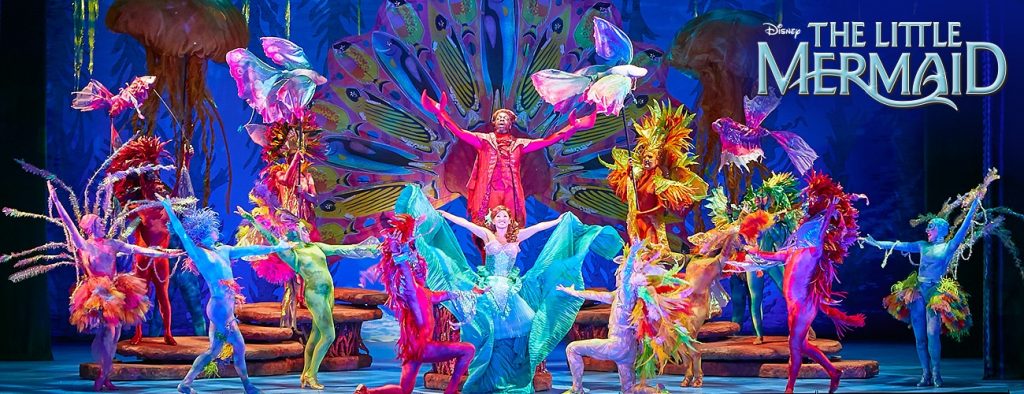By Martin Morse Wooster: The studios are busily trying to turn their films into musicals these days. Every studio is trying to do this; I once paid good coin to see Elf: The Musical (which had its moments). But Disney has probably put the most effort into turning its films into theatrical productions.
Go to Disney Theatrical Productions’ website and you’ll find they’ll happily sell you tickets to the Broadway productions of The Lion King, Aladdin, and Newsies. But the idea that Disney is an unstoppable theatrical juggernaut, in my view, rests solely on The Lion King, which was bold and innovative. My impressions of The Lion King are second-hand because the production has visited Washington twice, but both times the production went to the Kennedy Center, which never discounts. When I saw that the sell-through for The Lion King was north of 95 percent and the few available tickets were available on StubHub for three figures, I realized this show was too expensive for me.
There are lots of attempts by Disney to turn their films into musicals that have gone nowhere. The Hunchback of Notre Dame is one of the greatest Disney musicals, but Wikipedia tells me the theatrical version has only played in San Diego. Many other Disney musicals haven’t toured. But Disney’s The Little Mermaid was on tour, for five performances at Wolf Trap, which is our outdoor theatre that people go to in the summer. (Neil Gaiman will perform there on July 9.) The tickets were on Groupon, which is understandable because the performance I went to on a Thursday was half-full. So I wallowed in my discounted ticket.
The production I saw was, I think, the second national tour for The Little Mermaid, which was developed by Pittsburgh CLO and Kansas City Starlight, theatres in those cities that specialize in musicals. It played in Pittsburgh and Kansas City before coming in Washington.
You know the story. Ariel is the youngest daughter of King Triton, and she finds human boys attractive. So she steals the keys to the car…, oh, sorry. She floats around on the surface, where she attracts the eye of Prince Erik. She also collects a lot of human stuff, including a giant statue of a Roman emperor.
King Triton is outraged! So he throws out Ariel’s comic books…, oops. Sorry. He smashes her collection of human stuff and the giant statue falls and turns into rubble. “You worship rubbish!” the king thunders, and I made a note, “I must not let King Triton see my CD collection.”
So naturally Ariel wants to become a human. She goes to the king’s evil sister Ursula. Ursula has Ariel sign a contract where she gets to be a human for three days but she has no voice. She has to get Prince Erik to kiss her or her soul is Ursula’s. We learn Ursula is a squid, because she says one clause of her contract is a “squid pro quo.” “I’m a squid,” she explains, in case we didn’t get the joke.
So will Ariel convince Prince Erik to kiss her? Well, this is a happy musical. That’s all I say.
The Little Mermaid was the second feature of Alan Menken and Howard Ashman, who wrote The Little Shop of Horrors and were turned into megastars. They could have been one of the great teams in musical history, except that Ashman died in 1991 at age 41, having written the lyrics for Beauty and the Beast, The Little Mermaid, and three songs for Aladdin. Menken is still with us, and was happy to write more music.[1] But there are 20 songs in Disney’s The Little Mermaid, and only seven of them have lyrics by Ashman. The remaining 11 songs are by Glenn Slater, who is competent but second-tier. (Two songs are credited to both Slater and Ashman.)
The problem with Disney’s The Little Mermaid is that it’s like lots of other Disney films, but like Ariel, never really develops its own voice. Do you like sailors roistering in the sea like the ones in Peter Pan? Well, they’re here. How about evil stepsisters picking on Cinderella? Well, Ariel has seven sisters, all of whose names begin with A, and there’s a scene like the one with Cinderella’s glass slipper. How about an evil woman like Cruella DeVil? That is Ursula the squid.
The cast was, of course, competent. Diana Huey played Ariel. She is Asian American, and told the Kansas City Star that she thought she could be a role model for actors of color. Other standouts included Melvin Abston as Sebastian the crab (you know, the guy who sings “Under the Sea”) and Jennifer Allen as Ursula, who got to wear a purple gown with seven tentacles.
I thought Disney’s The Little Mermaid was a line extension of the Disney brand that wasn’t that original, but it was pleasant. Still, I saw a lot of 10-year-old girls having a happy evening with their mothers, and at least two Millennial women wearing mouse-ear dealy boppers. So I won’t grumble too much.
But if any other Disney musicals show up in Washington, well, I’m there!
[1] Menken’s work for Disney includes the remake to The Shaggy Dog, which lets me ask this trivia question. What’s the connection between The Shaggy Dog and Bambi? They’re both based on novels by Hungarian fantasy writer Felix Salten.
Discover more from File 770
Subscribe to get the latest posts sent to your email.


This is actually the second time, Martin, that The Little Mermaid has been staged in the D.C. area. Olney Theatre Center had a production of it a couple of years ago. The musical doesn’t come close to making it into my 10 Favorites list, but it did make for a pleasant and melodic evening of live theatre.